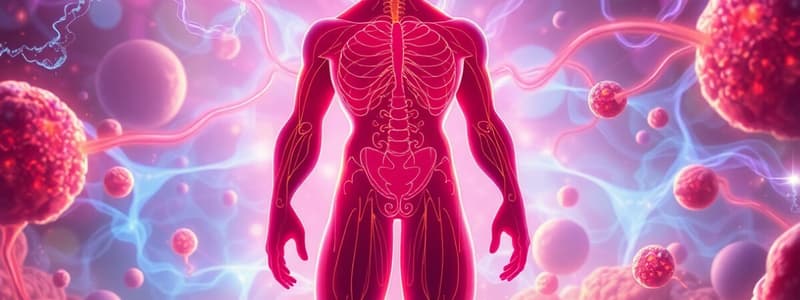Podcast
Questions and Answers
What is the initial product formed from glucose in the metabolism pathways described?
What is the initial product formed from glucose in the metabolism pathways described?
- Lactate
- Pyruvate
- Fructose
- Glucose-6-phosphate (correct)
Which enzyme is responsible for converting glucose to glucose-6-phosphate?
Which enzyme is responsible for converting glucose to glucose-6-phosphate?
- Lactase
- Amylase
- Maltase
- Hexokinase (correct)
During anaerobic glycolysis, what is glucose ultimately converted to?
During anaerobic glycolysis, what is glucose ultimately converted to?
- Pyruvate and lactate (correct)
- Oxygen
- Glucose-6-phosphate
- Fructose
Which of the following pathways is NOT mentioned as a metabolic pathway for glucose?
Which of the following pathways is NOT mentioned as a metabolic pathway for glucose?
What role does salivary amylase play in the digestion of carbohydrates?
What role does salivary amylase play in the digestion of carbohydrates?
What is the recommended timeframe for separating a serum specimen from cells?
What is the recommended timeframe for separating a serum specimen from cells?
What should be added if the serum specimen is delayed beyond the recommended separation time?
What should be added if the serum specimen is delayed beyond the recommended separation time?
What is the maximum recommended adult dose of glucose for testing?
What is the maximum recommended adult dose of glucose for testing?
How long should a patient fast before obtaining FBG?
How long should a patient fast before obtaining FBG?
What substance allows a whole blood sample to avoid glycolysis for up to 48 hours when refrigerated?
What substance allows a whole blood sample to avoid glycolysis for up to 48 hours when refrigerated?
Which method employs cuprous ions for glucose measurement?
Which method employs cuprous ions for glucose measurement?
What is the consequence of delaying the separation of a serum specimen beyond 30 minutes?
What is the consequence of delaying the separation of a serum specimen beyond 30 minutes?
What is NOT recommended regarding glucose testing for pregnant patients?
What is NOT recommended regarding glucose testing for pregnant patients?
What is the threshold for diagnosing diabetes using HbA1C?
What is the threshold for diagnosing diabetes using HbA1C?
At what fasting plasma glucose level is diabetes typically diagnosed?
At what fasting plasma glucose level is diabetes typically diagnosed?
Which of the following glucose levels corresponds to hypoglycemia symptoms?
Which of the following glucose levels corresponds to hypoglycemia symptoms?
What should be the plasma glucose level 1 hour after a meal for it to be considered normal?
What should be the plasma glucose level 1 hour after a meal for it to be considered normal?
How is fasting plasma glucose also referred to?
How is fasting plasma glucose also referred to?
What is the recommended screening period for all nondiabetic pregnant women for GDM?
What is the recommended screening period for all nondiabetic pregnant women for GDM?
What is classified as postabsorptive hypoglycemia?
What is classified as postabsorptive hypoglycemia?
What is the recommended threshold for 2-hour plasma glucose testing?
What is the recommended threshold for 2-hour plasma glucose testing?
Which hormone is directly responsible for stimulating the adrenal cortex to release cortisol?
Which hormone is directly responsible for stimulating the adrenal cortex to release cortisol?
What is the primary mechanism by which thyroxine increases plasma glucose levels?
What is the primary mechanism by which thyroxine increases plasma glucose levels?
How is Type 1 diabetes characterized in terms of insulin production?
How is Type 1 diabetes characterized in terms of insulin production?
Which type of diabetes is associated with gestational diabetes mellitus (GDM)?
Which type of diabetes is associated with gestational diabetes mellitus (GDM)?
Which antibodies are commonly associated with Type 1 diabetes?
Which antibodies are commonly associated with Type 1 diabetes?
What is the effect of somatostatin on insulin?
What is the effect of somatostatin on insulin?
Which of the following is NOT a characteristic of Type 1 diabetes?
Which of the following is NOT a characteristic of Type 1 diabetes?
Which process increases the level of glucose in the blood during times of fasting?
Which process increases the level of glucose in the blood during times of fasting?
Which of the following best describes the characteristics of Type 2 Diabetes?
Which of the following best describes the characteristics of Type 2 Diabetes?
Which complication is specifically associated with microvascular problems in diabetes?
Which complication is specifically associated with microvascular problems in diabetes?
What is the primary management strategy for Latent Autoimmune Diabetes of Adulthood (LADA)?
What is the primary management strategy for Latent Autoimmune Diabetes of Adulthood (LADA)?
Which of the following factors is not considered a risk factor for Type 2 Diabetes?
Which of the following factors is not considered a risk factor for Type 2 Diabetes?
Idiopathic Type 1 Diabetes is characterized by which of the following features?
Idiopathic Type 1 Diabetes is characterized by which of the following features?
Which hormone is increased in Cushing's Syndrome and can affect blood glucose levels?
Which hormone is increased in Cushing's Syndrome and can affect blood glucose levels?
Which of the following statements about insulin action in Type 2 Diabetes is correct?
Which of the following statements about insulin action in Type 2 Diabetes is correct?
What is the result of using hypoglycemic agents such as metformin?
What is the result of using hypoglycemic agents such as metformin?
Dilantin and Pentamidine are drugs that lead to which specific diabetes-related issue?
Dilantin and Pentamidine are drugs that lead to which specific diabetes-related issue?
Which symptom is commonly associated with hypoglycemia?
Which symptom is commonly associated with hypoglycemia?
How does Type 2 Diabetes primarily differ from Type 1 Diabetes?
How does Type 2 Diabetes primarily differ from Type 1 Diabetes?
Which of the following is a potential complication of diabetes that affects the nervous system?
Which of the following is a potential complication of diabetes that affects the nervous system?
What unique aspect characterizes the onset of Type 1 diabetes in adults?
What unique aspect characterizes the onset of Type 1 diabetes in adults?
Which genetic syndrome is associated with Type 2 Diabetes?
Which genetic syndrome is associated with Type 2 Diabetes?
Flashcards are hidden until you start studying
Study Notes
Fate of Glucose
- Most ingested carbohydrates are polymers like starch and glycogen
- Salivary and pancreatic amylases digest polymers into dextrins and disaccharides
- Maltase hydrolyzes disaccharides to monosaccharides
- Sucrose to glucose and fructose
- Lactose to glucose and galactose
- Monosaccharides are absorbed by the gut and transported to the liver via the hepatic portal venous blood supply
- 3 possible metabolic pathways for absorbed glucose:
- Glucose converted to glucose-6-phosphate using ATP (enzyme: hexokinase)
- Embden-Meyerhof pathway
- Hexose Monophosphate Shunt
- Glycogenesis
Embden-Meyerhof Pathway for Anaerobic Glycolysis
- Glycolysis is the conversion of glucose to pyruvate and lactate
- Anaerobic glycolysis occurs when oxygen is not a concern
Diabetes Mellitus
- A group of metabolic diseases characterized by hyperglycemia, resulting from defects in insulin secretion, insulin action, or both
- Two main types:
- Type 1
- Type 2
- New categories of diabetes (ADA/WHO):
- Type 1 diabetes
- Type 2 diabetes
- Other specific types of diabetes
- Gestational diabetes mellitus (GDM)
Type 1 Diabetes
- Insulin-dependent diabetes mellitus (IDDM), juvenile-onset diabetes mellitus, brittle diabetes, ketosis-prone diabetes
- Result of cellular-mediated autoimmune destruction of the beta cells of the pancreas leading to an absolute deficiency of insulin secretion
- Antibodies associated with type 1:
- Islet cell autoantibodies (ICA)
- Insulin autoantibodies (IAA)
- Glutamic acid decarboxylase autoantibodies (GADA)
- Tyrosine phosphatase IA-2 and IA2B autoantibodies
- Zinc transporter 8 antibody (ZnT8)
- Constitutes only 5% to 10% of all diabetes cases
- Risk factors:
- Genetic, autoimmune, environmental
Type 2 Diabetes
- Non-insulin-dependent diabetes mellitus (NIDDM), maturity onset or adult type DM, stable diabetes, ketosis-resistant diabetes, receptor-deficient DM
- A result of an individual’s resistance to insulin with an insulin secretory defect (relative insulin deficiency)
- Constitutes the majority of diabetes cases
- Characteristics:
- Usually more gradual symptom onset
- Insulin independence (initially)
- Ketoacidosis uncommon
- Risk factors:
- Genetic, obesity, sedentary lifestyle, race/ethnicity, PCOS, dyslipidemia, hypertension
- Complications:
- Macrovascular and microvascular
- Uses hypoglycemic agents to regulate blood sugar level (e.g., metformin)
Other Specific Types of Diabetes
- Associated with secondary conditions:
- Genetic defects of beta cell function or insulin action
- Pancreatic disease or injury
- Endocrine disease
- Example conditions: Cushing’s syndrome, pheochromocytoma
- Drug or chemical-induced receptor abnormalities
- Example drugs: Dilantin, Pentamidine, Thiazides
- Other genetic syndromes
- Example: Down syndrome
Criteria for Testing and Diagnosis of Diabetes Mellitus
- HbA1c ≥ 6.5% using a method that is NGSP certified and standardized to the DCCT assay
- HbA1c also known as glycosylated hemoglobin
- Fasting plasma glucose also known as fasting blood sugar
- Random plasma glucose also known as random blood sugar
Criteria for Testing and Diagnosis of Gestational Diabetes Mellitus
- International Association of the Diabetes and Pregnancy Study Groups recommend screening for all nondiabetic pregnant women at 24 to 28 weeks of gestation
Hypoglycemia
- 65 to 70 mg/dL (3.6 to 3.9 mmol/L) - glucagon and other glycemic factors are released
- 50 to 55 mg/dL (2.8 to 3.1 mmol/L) - observable symptoms of hypoglycemia appear
- Classification:
- Postabsorptive (fasting) - associated with insulinoma
Glucose Measurement Methods
- Alkaline Copper Tartrate + Heat -> Cuprous Ions
- a. Folin Wu Method
- Cuprous Ions -> Phosphomolybdate -> Phosphomolybdic Acid or Phosphomolybdenum Blue
- This is a colorimetric measurement
Studying That Suits You
Use AI to generate personalized quizzes and flashcards to suit your learning preferences.




